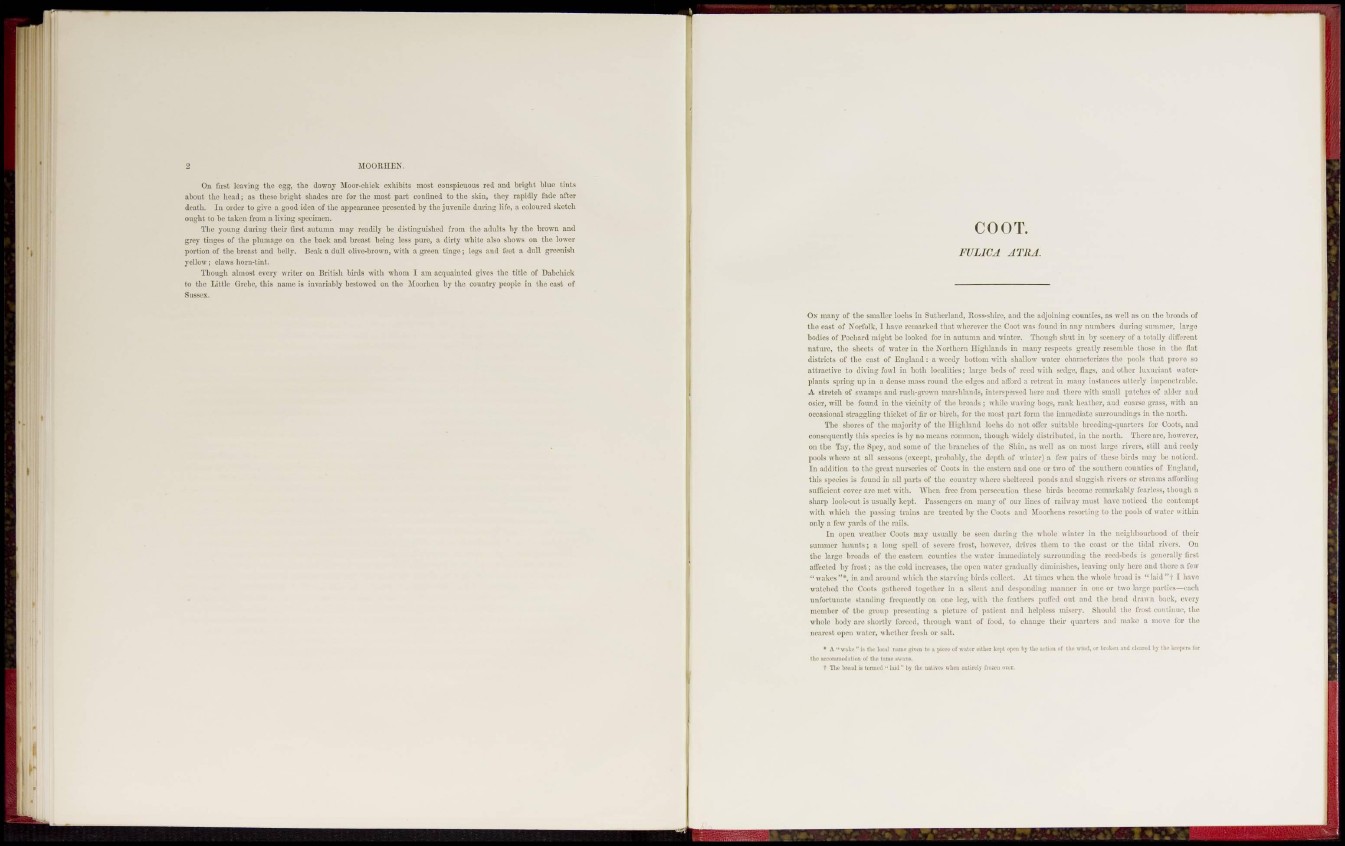
On first leaving Hie egg, the downy Moor-chick exhibits most conspicuous red and bright blue tints
about the head; as these bright shades are fur Ihe most part confined to the skin, they rapidly fade after
death. In order to give u good idea of the appearance presented by the juvenile during life, a coloured sketch
ought to he taken from a living specimen.
The young during their first autumn may readily be distinguished from the adults by the brown and
grey tinges of the plumage 011 the hack and breast being less pure, a dirty white also shows on the lower
portion of the breast and belly. Beak a dull olive-brown, with a green tinge; legs and feet a dull greenish
yellow; claws horn-tint.
Though almost every writer on British birds with whom I am acquainted gives the title of Dabohick
to the Little Grebe, this name is invariably bestowed on the Moorhen by the country people in the east of
Sussex.
COOT.
FÚLICA ATRA.
Os many of the smaller lochs in Sutherland, Ross-shire, and the adjoining counties, as well as on the 1 Is ol
the east of Norfolk, I have remarked that wherever the Coot was found in any numbers during summer, largo
bodies of Pochard might be looked for in autumn and winter. Though shut in by scenery of a totally different
nature, the sheets of water in the Northern Highlands in many respects greatly retemblé those in the flat
districts of the east or England : a weedy bottom with shallow water characterizes the pools that prove so
attractive to diving fowl in both localities; largo beds of reed with sedge, Hags, and other luxuriant waterplants
spring up in a douse mass round the edges and afford a retreat in many instances utterly impenetrable.
A stretch of swamps and rush-gruwii marshlands, interspersed here and there with small patches of alder and
osier, will be found in the vicinity of the broads ; while waving bogs, rank healher, and coarse grass, with an
occasional straggling thicket of lit- or birch, for the most part form the immediate surroundings in the north.
The shores of the majority of the Highland lochs do not oifer suitable breeding-quarters for Coots, and
consequently this species is by no mi-aus common, though w idely distributed, in the north. There are, however,
on the Tay, the Spey, and some of the branches of the Shin, as well as on most large rivers, still and reedy
pools where at all seasons (except, probably, the depth of winter) a few pairs of these birds may be noticed.
In addition to the great nurseries of Coots in the eastern and one or two oí the southern counties of England,
this species is found in all parts of the country where sheltered ponds and sluggish rivers or streams affording
sufficient cover are met with. "When free from persecution these birds become remarkably fearless, though a
sharp look-out is usually kept. Passengers on many of our lines of railway must have noticed the contempt
with which the passing trains are treated by the Coots and Moorhens resorting to the pools of water w ithin
only a few yards of the rails.
In open weather Coots may usually be seen during the whole winter in the neighbourhood of their
summer haunts; a long spell of severe frost, however, drives them to the coast or the tidal rivers. On
the large broads of the eastern counties the water immediately surrounding the recd-heds is generally first
affected 1A frost ; the cold increases, the open water gradually diminishes, leav iug only here and there a few
"wakes"*, in and around which the starving birds collect. At times when the whole broad is " laid"t I have
watched the Coots gathered together in a silent mid desponding manner in one or two largo parlies—each
unfortunate standing frequently on one log, with the fea then pulled out and the head drawn back, every
member of tin- group presenting a picture of patient and helpless misery. Should the frust continue, the
whole body are shortly forced, through want of food, to change their quarters and make a move for the
nearest open wafer, whether fresh or sail.
• A " wall- " i« Ha- local name BHVCB to a pii-co of «rattt either lí¡it open by the action of the wind, or hrulivn and tfiítred k) Iho kMM for
t The broad la termed "laid" by the MHIM when eulin-lv M a Kw.